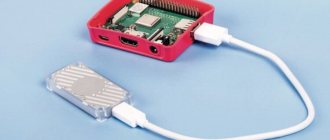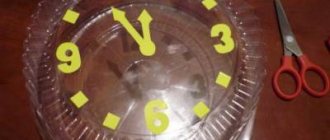If you take a piece of paper, a printer pen, scissors and glue...
At summer computer school, we sometimes invite children to assemble a “biocomputer,” that is, a computing device from what is literally lying under their feet. Since children do not know very well how computing devices work, they usually end up with something like a spoiler picture. But some still do abacus or abacus. Biocomputer
And recently I came across a description of a computer model made of paper, developed in 1968 at Bell Labs. The computer is called CARDIAC (CARDboard Illustrative Aid to Computation), which roughly translates to Cardboard Visual Aid to Computation. That is, in fact, it is not really a computer, since a person acts as a conductor of signals, as well as an arithmetic-logical device in it. However, it does provide insight into some of the principles underlying modern computing. In addition, after a short search, I found a description and materials for making CARDIAC.
CARDIAC consists of two blocks - memory and processor. Several paper strips are inserted into the processor unit with the help of which you need to select the instruction to be executed. In addition, a tape with output data is inserted into the memory block, and a tape with input data is inserted into the processor.
How to make a toy laptop?
The laptop that will be folded out is made from the following materials:
- Thick cardboard
- Black background (paper)
- Glue
- Pencil and ruler
- Scissors
You need to cut out two squares from cardboard, which are connected to each other with adhesive tape. You can take a solid piece of cardboard, which you just need to bend in half. You also need to cut out the keyboard, screen bezel and mouse from cardboard. The keys are also cut out of cardboard and glued to the keyboard.
Black paper is glued in place of the screen; you can use slate paper, on which you can draw with crayons and erase them. The top cover of the laptop can be covered with stickers or the child’s signature can be made.
Triangular shoe rack made of cardboard boxes
- scissors or stationery knife
- Ruler and pencil
*Each module in this shelf is a triangular tube. Its size depends on the shoe size.
First you should make one module.
1. First, cut the cardboard, divide it into 3 parts with a pencil and a ruler, bend it into a triangle and secure with wide tape.
2. Create some more modules in this way.
3. Each row of triangular modules must be glued to a sheet of cardboard for stability.
4. You can put another cardboard on top.
Cardboard computer
Cardboard is a very versatile material from which you can make a lot of interesting crafts. If you don’t know how to make a computer out of cardboard with your own hands, then detailed instructions will help you cope with this task.
Try making a desktop version of the computer. First you need to decide on the size of the monitor, for which you need to make a durable stand from thick cardboard. Making a desktop computer is as easy as making a laptop; the materials used are the same.
Smartphone based
Mobile phones are used not only for long-distance communication, but also for exchanging video data. That is why the idea of making a projector from a pocket gadget arose. Theoretically, the process of obtaining an image consists of converting a graphic signal from the display through an optical lens to any surface. To do this, you need to make a case that completely darkens the surrounding space, and mounting devices for both the lens and the mobile device.
It's quite easy to pick up a magnifying glass or magnifying glass. The main thing is that its overall dimensions are commensurate with the size of the phone screen. You can use the front wall of the case to fix the magnifying glass. To secure the phone vertically, you can use a cardboard box or cardboard ribs in which the mobile phone will not wobble. The easiest way to make a housing is from a cardboard box, since it is easy to cut a hole in it with the required parameters without special equipment.
For work you will need tape, glue, a stationery knife, pencil, ruler and compass.
The process of making a projector from a smartphone is as follows:
- Choose one of the walls of the box so that the distance from it to the opposite one is greatest. This will provide a wider range for customizing display options.
- Mark the middle on the selected wall, around which cut a hole for a magnifying glass. Rice. 4: make a hole for the magnifying glass
- Attach a magnifying glass to the side of the box. To do this, you can use either tape or good glue; it is important that they do not get into the lumen of the lens, otherwise it may ruin the image from the projector. Rice. 5: Attach the magnifying glass
- Make a holder for your mobile phone; it is important that during installation it does not cover the display and fits inside the box. Rice. 6: Make a holder
- To adjust the image experimentally, select the most optimal distance from the mobile to the magnifying glass. Rice. 7: choose the distance
- Make a hole for the mobile charging cord to lead it out of the box.
The projector from your smartphone is ready, you can start broadcasting, but first install a special application that will rotate the image 180°. In some phone models, it is enough to disable auto-rotate screen and install the gadget upside down. It is better to organize viewing in a well-darkened room to increase the clarity and brightness of the picture.
In addition, a holographic projector can be made from a mobile phone and polymer plates (Fig. 8). But the cost of such a homemade product will amount to a considerable penny, with a relatively low image quality, so it can compete with the above-described sample only in the originality of the picture.
Rice. 8: Example of a holographic projector
Computer for dolls
Every child who plays with dolls loves to add different elements to the play process. A computer will be a pleasant surprise for a child, and you can make a simple version for dolls yourself.
Almost all toy equipment is made of cardboard and paper; in this case, it is necessary to select the size of the computer that matches the size of the doll.
You can decorate your finished computer with colorful paper, appliqués, stickers, or simply paint it. You can draw the keyboard on cardboard or make small blanks for it, which are glued to the bottom of the laptop.
Useful video lessons on how to make a computer for dolls with your own hands can be an excellent help in this matter.
Laptop based projector
This option is good because it allows you to get a good quality image due to the fact that the screen in the device is much larger than in a smartphone. But at the same time you need to find a large magnifying element; a Fresnel lens or a special element for full-page reading of books is best. As for the work, it should be organized like this:
- The main thing is to find a box of the right size. One side should be slightly larger than the laptop monitor, and the distance between the walls should be at least 50 cm to ensure normal image magnification. At the same time, the box must be strong enough to support the laptop lying on it, this is an important point.
To use the laptop you will need a box and a larger lens. This is how the laptop is placed on a homemade projector.
Some make the box sliding so that you can adjust the image and change the distance between the screen and the lens. To do this, you can select two boxes that fit tightly into each other and cut off the two walls located inside them.
Useful tips for making
- Before you start, prepare all the necessary materials that you will use for the craft.
- You need to choose the type of computer, decide on its logo and depict it as accurately as possible on the case.
- You can recreate all the necessary icons on a paper desktop, stick them on, or simply draw them on the screen using colored markers or pencils.
- You can print a photo in advance that will serve as a background for your computer screen.
- When making a keyboard, you can prepare the keys in advance and draw each of them by hand, so the computer will turn out to be more realistic.
- For a desktop computer or laptop, you need to make a durable stand from thick cardboard.
- You can use any decorative elements for the toy that your child likes.
Various photos of a computer made with your own hands will help you create such a toy yourself and delight your child with an excellent craft that will become an indispensable part of his game.
Theory
The principle of transmitting an image from any medium to a vertical surface is based on the laws of optics. When various carriers interact with the light flux, the rays are refracted, the spectrum changes, and is subsequently displayed on the screen.
A homemade projector can be implemented in different ways. In practice, there are several image transmission technologies that are implemented in all kinds of filmoscopes, sliders and projectors. The most popular design solutions are:
where from the light source 2 the flow is directed by the reflector 1 to the slide 4 located in the focusing lens 3. The modified spectrum extends to the optical amplifier 6 and is transmitted to the screen 7.
The figure above shows the principle of operation of a reflective type projector, in which a light source 1 transmits a flux that is reflected by mirrors 2 and falls on an image 3. The modified light flux moves through the lens to a reflector, which transmits the image to the screen.
- Film projectors - transmit video information from moving film slides when a light flux passes through them.
- DLP projectors – broadcast video information by reflecting the light flux from a special chip. The flow itself is formed by a color logical matrix. Such devices provide high image clarity and color accuracy. Rice. 3: Schematic diagram of DLP projector
- LCD projectors - realize image transmission by passing light through a transparent LCD panel. Unlike DLP technology, LCD projectors produce bright, vibrant and rich colors.
Today, digital multimedia projectors can easily compete in photo and video quality with the best HD TVs. Therefore, home projectors can be used as a personal cinema for family movie viewing or as a means of displaying visual materials at conferences and lectures. Alas, it is almost impossible to recreate a digital multimedia device with your own hands, since it is necessary to synchronize the operation of mechanical, optical and digital elements. But anyone can implement a classic projector using digital equipment.
Additional items
Making a simple cardboard computer requires few materials and is an extremely simple job. Sometimes you can get broken parts of a real device, this could be an old mouse or a non-working keyboard.
In this case, it will be a little more interesting for the child to press the keys during the game, because the computer will become more realistic. Use prints of brightly colored desktop wallpapers with pre-made icons to create a more realistic look for your computer.
Ways to improve picture quality
To increase the image clarity from a homemade projector, you need to perform the following simple measures:
- Set the monitor to maximum brightness and contrast - this will improve the quality of the picture.
- Eliminate any cracks or gaps in the projector cabinet that could allow excess light to enter.
- Paint the inside walls of your homemade projector black. If possible, it is better to cover it with black velvet fabric to minimize the reflection of light from the walls. Rice. 16: Paint the walls black
In addition, external factors also affect the quality of the projector’s broadcast. So, in order for the picture to be well perceived, the windows should be covered with curtains during daylight hours, and at night all lighting sources should simply be turned off. Remember, the shorter the distance to the screen, the higher the image quality on it. The screen itself also matters - it is preferable to have a smooth, monochromatic surface in calm colors.
To watch movies and images, you can create not only a simple projector for your phone with your own hands, advertising logos, but also more complex designs using spare parts from electronics, ready-made control modules. The picture of a primitive homemade product will be a little blurry, but this will be enough for watching feature films. And if you approach the assembly thoroughly and create an LED projector, then in terms of functionality it will be comparable to factory models and at the same time will be several times cheaper.
Paper model of computer
A paper computer is made according to the same principle as the cardboard version. You can make such a craft together with your child; he will certainly enjoy this activity. You can make a computer out of paper that will be as similar as possible to real equipment.
To do this, you need to pay attention to the smallest details, recreating each key separately, including the touchpad and cable connectors.
By making a paper computer, you can teach your child how this unit works. If you don’t know how to make a computer out of paper with your own hands, then detailed instructions will be your best adviser in this matter.
Projector from slide viewer
Making a projector from a ready-made unit greatly simplifies the task, since you no longer need to make any adjustments in terms of optical effects. These settings are made at the factory and the slide viewer perfectly displays graphic objects from paper or other A4 format media. Your only task is to choose the most suitable photo-video signal translator. In this example, we will look at making a projector from a working tablet monitor that fits the size of the diascope.
To do this you will need to do the following:
When dismantling the matrix, be extremely careful not to damage the fragile element.
- Along with the LCD panel, remove the electronic board of the tablet, as it will be used to connect to the PC for data transfer.
- Place the matrix on the glass with a gap of about 5mm between them. Rice. 14: Install the LCD panel on the glass
The distance is necessary for ventilation, since a powerful stream of light will also cause excessive heating of the surface.
Due to its low weight, it is attached using double-sided construction tape.
The projector is ready - just connect both devices to the network and launch the desired video material through the computer. With this projector you will get fairly high image quality, which, as a rule, depends little on the distance to the screen. It should be noted that smaller devices for viewing slides that will be comparable to the screen of a smartphone can be found on sale.
detailed instructions
- Prepare two sheets of thick paper or cardboard of the same size. This will be the base and the lid, which are connected to each other with tape; you can also use threads and sew these two parts together;
- Then you need to move on to making the keyboard. Use a real keyboard as an example, drawing the characters in the order they should appear. The keyboard and keys can be made in any color that the child likes;
- The screen can be drawn or printed on a printer. You can make a replaceable screen, it will be much more interesting to play. Make it as realistic as possible, because even a toy computer should look like a real unit;
- For the screen you need to use a frame made from two strips of cardboard. You only need to secure the frame at the edges; only in this case will it be possible to use replaceable work tables;
You can also use a ready-made cardboard box for sweets or shoes as a base, and everything else can be made with your own hands, taking into account the wishes of the future owner.
How does it all work?
The functioning of a computer consists of sequential execution of instructions. Before starting execution, you need to look where the ladybug is located (that is, the instruction counter) and, by moving the strips, enter the value from this memory cell in the “Instruction Register” window.
Then you need to follow the arrows, starting with the inscription “Start” and follow all the instructions. For example, in the picture below, you first need to advance the instruction counter forward, and then add the contents of cell 41 to the accumulator.
Of course, calculations (addition, subtraction and shift) will have to be done manually. To do this, next to the inscription “Accumulator” there are several windows that allow you to perform addition/subtraction in a column.
To begin with, I “entered” (that is, wrote with a pencil into memory cells from 17 to 23) the first of the programs given in the manual:
| Address | Meaning | Decoding |
| 17 | 034 | Enter a value in cell 34 |
| 18 | 035 | Enter a value in cell 35 |
| 19 | 134 | Copy cell 34 to accumulator |
| 20 | 235 | Add cell 35 to the battery |
| 21 | 636 | Write the accumulator to cell 36 |
| 22 | 536 | Output cell 36 |
| 23 | 900 | Stop and reset |
This program adds two numbers read from the input tape and writes the result to the output tape. The input instruction reads a value from the input tape, writes it to the specified location, and then moves the input tape forward one step so that the next value appears in the Input box. In this case, you will have to use a pencil (and possibly an eraser) to write the value into the memory cell.
After executing this program with input values 42 and 128, the memory state became as follows:
Secure the CPU cooler
Shot: @TehnoBelka / YouTube
Next, a radiator with a fan is installed on the processor. They can either come bundled with the processor (usually simpler versions) or be purchased separately (effective solutions for productive systems).
Clean the processor cover with a cloth soaked in degreaser and apply a small amount of thermal paste to the surface. Spread the mixture evenly in a thin layer using a plastic card or your finger wrapped in a plastic bag. Complete coolers usually already have thermal paste.
Shot: @TehnoBelka / YouTube
Place the heatsink on the processor and secure it. Depending on the cooler model, fastenings can be latches with pressure, rotary clamps, or screws screwed through a metal plate on the back of the motherboard. Connect the fan cable to the connector labeled CPU_FAN.
If you are using a large cooler with a massive radiator, then it is better to mount it after installing the motherboard in the case. Otherwise it will be difficult to put it in place.
Projector from a slide device
If you have a used or unnecessary device for slides, you can use it for a projector. Moreover, in the future it will be possible to assemble it back. No manipulations with the optics are required - everything is already ready. The device displays pictures in A4 format, that is, it is advisable to choose a larger display, from a tablet or laptop.
- We disconnect the matrix from the tablet and the board.
- We place the display on the glass, the gap is 4–6 mm.
- We install a small cooler on the side, you can glue it with double-sided tape.
- We connect the tablet to the network.
If you are using a laptop and decide to install the keyboard unit separately (this will make it convenient to operate), then you will need an extension cable. But you can also try the “humane” method: open the gadget and place the screen on the glass of the slidescope, and hang the part with the keyboard to the side or leave it in a horizontal position. But then you can control it without removing the gadget only with a mouse, however, this is quite enough for viewing videos and pictures.
Deciding on the size and purpose of the craft
Why make a paper model of a computer? There can be many options - a simple toy for a child, an accessory for his doll, a postcard for an adult lover of high technology, or a comic gift. Only the size changes, and the basic step-by-step instructions on how to make a notebook out of paper are the same for all crafts.
It is not difficult to guess that the doll and the child himself need computers of different sizes. If you are making a card as a gift, choose an arbitrary perimeter of the blank. An interesting idea is to make a model of a laptop and give it as a gift in a box from a real PC. Just keep in mind that such a gift should only be given to a person with a good sense of humor. If you have doubts about the recipient's reaction, abandon the idea.
Command system
Each instruction is encoded using a three-digit decimal number.
The first digit is always the operation code. The remaining two digits usually represent the address of the cell that the instruction operates on. CARDIAC can "execute" 10 different instructions (codes 0 to 9):
- 0 - INP - enter a value from the input tape
- 1 - CLA - loading the contents of the memory cell into the battery
- 2 - ADD - adding a memory cell to the battery
- 3 - TAC - jump to the specified address if the accumulator value is negative
- 4 - SFT - shift operation left and right by a specified number of decimal places
- 5 - OUT - output of the memory cell to the output tape
- 6 - STO - writing the battery to a memory cell
- 7 - SUB - subtracting a memory cell from the battery
- 8 - JMP - unconditional jump to a given address
- 9 - HRS - stop and reset
Prepare the body
Shot: @TehnoBelka / YouTube Unpack and remove the system unit case from the box.
Using your hands or a screwdriver, unscrew the mounting screws on the rear wall and remove both side covers. Set them aside. Most cases are universal and support motherboards of several form factors: from full-size ATX to smaller Mini-ITX. Compatibility is ensured by rearranging the guides in the form of double-sided screws, through which the board is attached to the chassis.
Shot: @TehnoBelka / YouTube
Carefully try the board into place. Align the connector panel with the cutout on the back wall, as well as the mounting holes on the board and case. Screw the guides into at least 6-8 points around the perimeter and center of the part.
Never mount the motherboard directly to the chassis without using guide rails; this may cause short circuits and damage to electronic components.
The necessary double-sided screws are included in the kit and can even be pre-installed. In this case, check whether their location matches the holes on the board and rearrange them if necessary.
Currently reading











